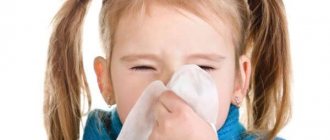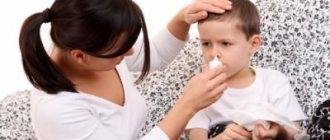The baby's throat is red, what should I do?
A red throat in a baby is a clear symptom of a progressive disease.
This illness causes serious inconvenience and discomfort for the child, the cause of which parents may not immediately identify.
Proper treatment of a baby’s throat will allow you to quickly remove the resulting swelling and get rid of the underlying disease, the symptoms of which can be snot, cough and runny nose.
Causes of red throat in children
In children under one year of age, the root cause of the appearance of a red throat may be inflammatory processes associated with viral or bacterial infection. When the body is affected by an infection, the tissues are saturated with blood, painful swelling is formed, the appearance of which is often accompanied by a sharp increase in the child’s temperature.
There are important differences between viral and bacterial infections:
- viruses penetrate the human body more easily, so they often cause illness in children under one year of age
- with a viral infection, the incubation period does not exceed 7 days; with a bacterial infection, it can reach from two to three weeks to one month
- with a bacterial infection, symptoms are difficult to detect; with a viral infection, the child’s temperature rises, a dry cough occurs, a runny nose and snot appear, and the throat turns red
- The symptoms of a viral infection are similar to acute respiratory infections, while a bacterial infection is more dangerous
- Bacteria can also infect a healthy body, while viruses are active only when the child’s immune system is weakened.
- antibiotics are most effective exclusively in the treatment of bacterial diseases; viral infections are not susceptible to their action
- viruses often cause redness of the skin; with bacterial infection, the skin usually becomes pale and painful
As a result of viral infections, a child may develop the following diseases: pneumonia, otitis media, bronchitis, sinusitis. These ailments usually have to be treated after the child has come into contact with sick children.
Against the background of reduced immunity after acute respiratory viral infection in infants under one year old, a bacterial infection can also join the virus. In this case, there is a high risk of developing tonsillitis, pharyngitis or complex forms of infectious diseases, such as scarlet fever.
Bacteria can enter a child’s body with unwashed food, personal items (handkerchiefs, towels), and in crowded places (swimming pool, gym, playroom).
In babies under one year old, the tonsils are the first to suffer from viral infections. Painful sensations spread to the mucous membrane of the throat, causing discomfort in the baby, which, due to his age, he cannot notify.
Treatment of a red throat in a baby
The first signs of the disease that parents can independently identify in a child under one year old are:
- changes in the structure of the throat (the appearance of ulcers, swelling, inflamed areas)
- baby has pain when swallowing, crying, breathing
- tongue swelling
- elevated temperature due to inflammation of the lymph nodes
- vomit
- lack of appetite
- coughing
- snot and runny nose that do not go away over a long period of time
It is necessary to treat a sore throat in a child a few months old under the supervision of a competent specialist. Banal cough, snot, runny nose, red throat can indicate either normal hypothermia or be symptoms of complex bacterial infections.
If the same cough or runny nose is not difficult to identify, then treating a throat in infants is not an easy task. In medicine, a number of methods and broad-spectrum drugs are used for these purposes.
Rinsing (irrigation)
Throat diseases in children can be effectively treated using the gargling method. During the process, plaque, mucus, pathogens and their environment are removed from the tonsils, recovery occurs quickly, and the temperature decreases. But for children a few months old, rinsing is unrealistic, so it is replaced by irrigation.
You can treat a sore throat in a baby using irrigation using the following formulations:
- warm saline solution: a teaspoon of salt per 200 ml of water, the optimal temperature of the composition is 35C
- infusion of medicinal herbs: plants with antiseptic and anti-inflammatory effects are suitable (sage, chamomile, eucalyptus)
- honey solution
- chlorophyllipt (non-alcoholic form - oil suspension)
- aloe juice (treatment is especially indicated for sore throat)
Irrigation is done after eating; it is better to use a spray bottle with a long and thin spout.
Inhalations
During inhalation, medications quickly reach the source of infection (throat mucosa) and relieve inflammation. A nebulizer is used for the procedure. As medications for children whose age is no more than 2-3 months, you can use saline solution, soda buffer, ambrobene, in difficult cases - Ventalin (diluted with saline solution).
Using inhalations, you can effectively treat snot, runny nose, and cough at home. After the procedure, you cannot go outside with your child or feed him for at least an hour. Doctors have differing opinions regarding whether inhalations can be performed if the patient has a fever. Most pediatricians recommend lowering it first and then inhaling it.
Medications
It is strongly recommended not to treat a sore throat with self-prescribed medications for an infant under 12 months of age. For these purposes the following can be used:
- tantum verde (treatment of sore throat, pharyngitis, tonsillitis)
- Theraflu Lar (for purulent formations on the tonsils, treatment of viral infections);
- efizol (relieves inflammation, temperature decreases faster).
After examining the baby, the doctor may additionally prescribe antibiotics (sumamed, amoxiclav, ciprolet, bioparox).
Komarovsky about the problem of red throat
Komarovsky confirms that in 90% of cases associated with intense sore throat in babies under 12 months of age and a little older, ARVI is diagnosed.
With this disease, along with a sore throat, a runny nose or nasal congestion occurs. If your child's nose is dry and his throat is red, these may be signs of sore throat or diphtheria.
Parents should also be alert to the baby’s high body temperature in such a situation.
Discomfort in the throat may also appear due to a critically low level of humidity in the room. The doctor strongly recommends using humidifiers and maintaining optimal temperature conditions in the nursery.
Source: https://chibi-co.ru/article/u-grudnichka-pokrasnelo-gorlo-chto-delat
How to cure a child’s throat under one year old: remedies and tips
Every child develops a sore throat sooner or later. Parents should recognize this symptom in time and take the necessary measures. When a child under the age of 1 year has a sore throat, it is doubly unpleasant, because at this age the baby cannot complain to his mother about his well-being.
How to treat the throat of a child under one year old, because at that age most medications cannot be taken? In this situation, parents should be able to provide the necessary assistance.
Causes of the disease and its symptoms
Parents are not always able to recognize the disease in a timely manner, because at this age babies can behave capriciously for many reasons: painful teething, enterocolitis, hunger, fatigue.
Not all diseases of the larynx cause fever, but the child’s excessive restlessness, crying and loss of appetite, especially refusal of complementary foods, should alert you.
A sore throat can also be a signal of certain diseases: ARVI, laryngitis, scarlet fever, tonsillitis, measles, influenza. Only a doctor can accurately determine the cause and give recommendations for treatment. Signs that a child has started an inflammatory process may include:
- Crying during feeding and refusal to eat.
- Fever.
- Anxiety and frequent moodiness.
- Enlarged lymph nodes.
It is extremely difficult to independently assess the condition of a baby’s throat, but it is possible if you use a flashlight or a small spoon. If you notice a coating on the tongue or at the base of the tongue, redness of the upper part of the larynx, swelling of the tonsils or the appearance of pustules, you should immediately consult a doctor.
If the cause is a viral disease, then a high temperature in the baby can occur from the first day of illness, and if it is bacterial, the disease will develop slowly. Fever may appear on the third or fourth day after loss of strength.
During an allergic reaction, the temperature may not rise, and symptoms usually go away quickly after the disease is eliminated.
Another cause of sore throat can be teething. A runny nose appears, and mucus from the nose enters the larynx, causing irritation, pain and a slight cough.
Drug treatment
The type and methods of treating a child under one year old using medications can only be determined by the attending pediatrician. The list of permitted drugs is small, so you cannot use drugs that are prohibited for his age category to treat a child. After the examination, the pediatrician will determine the type of disease, its causes, and prescribe the necessary medications.
In young children, redness of the throat is often accompanied by coughing and runny nose; therefore, the famous doctor Komarovsky advises rinsing the nose with herbal decoctions, saline or sea water-based products. This will prevent the proliferation of germs, clear the nose, relieve inflammation and eliminate a sore throat.
Virus
How can I help my child with a sore throat if the doctor has diagnosed a viral infection? In such situations, the following drugs that have an antiviral effect may be prescribed:
- Anaferon is used for the prevention and treatment of acute infections (ARVI, influenza), and can be taken from one month of age. The tablet is dissolved in a tablespoon of warm boiled water and given according to the available instructions and the advice of the pediatrician. The course of treatment is from five to seven days.
- Viferon - antiviral suppositories, which are prescribed 1 pc. per day. Treatment occurs in the same way for 7 days.
How to treat a red throat in a baby: basic treatment methods
Hello, dear parents. Unfortunately, all kids get sick, some more often, some less often, but each illness literally unsettles the whole family. What to do, for example, how to treat a red throat in a baby? But it is this problem, along with teething and a runny nose, that most often worries children. Let's look for a panacea for this problem together!
Possible reasons
Inflammation of the throat mucosa can be caused by various sources, the most common of which are:
- The virus is now hovering in the air, waiting for a weakened immune system, and children in this sense, unfortunately, are easy prey. Therefore, every mother more than once encounters manifestations of a viral infection, which is characterized by fever, runny nose, and general ill health, which is expressed in the baby’s capriciousness. Well, and, in addition, the throat hurts, which may affect the deterioration of appetite.
- A bacterial disease is, for the most part, a well-known sore throat, in which purulent rashes and plaques form on the surface of the throat mucosa; the baby is bothered by muscle pain and high temperature (usually about 39 degrees).
- Allergies to dust, household chemicals, certain foods or complementary foods can also result in redness of the mucous membranes.
- Rhinitis, that is, accumulation of mucus in the baby’s nasal passages. Due to the fact that the baby does not yet know how to blow out his nose, all the secretions flow down the wall of the nasopharynx, which is why the snot in the throat begins to irritate the mucous membrane, causing redness.
- A cold, that is, hypothermia of the body.
- Teething also often causes local reactions; in this case, nothing additional needs to be done - after the tooth appears, all unpleasant symptoms will go away on their own.
When to contact doctors?
Before treating inflammation, you need to determine its cause. For example, in case of allergies, you need to remove the irritating factor and give the baby antihistamines for a couple of days.
In case of such a reaction during teething, you can also just wait.
Colds and viral infections can be treated at home with medications prescribed by a doctor, rinses, inhalations and folk remedies proven over centuries, but bacterial ailments require medication.
So, you should definitely consult a doctor if:
- the baby is breathing heavily, wheezing, crying hoarsely - this is a sign of narrowing of the pharynx (for example, with laryngitis), which is very dangerous for babies and can even cause suffocation;
- presence of temperature above 38.5;
- presence of plaque on the throat;
- general poor health - poor appetite, lethargy, discomfort throughout the body, pale skin.
Inhalations
Water inhalations helped my baby relieve inflammation from his throat. To do this, I boiled herbs that have an anti-inflammatory effect (chamomile, calendula, sage, pine needles) in advance at the rate of a tablespoon per glass of boiling water. After this, she poured the broth into a container of hot water and sat down next to it with the child, covering herself with a large towel.
I would like to note that you need to adjust the temperature of the water so that it warms up pleasantly, but does not burn you, and sit there for no more than 5 minutes. Naturally, such a procedure becomes possible only after 6-7 months; before that, the baby simply will not be able to sit and understand what they want from him.
It is better to carry out inhalations in the evening before bedtime, so that the child stays warm longer.
Aromatherapy
The ease of treatment is also pleasing - all you need to do is pour a little boiling water into the aroma lamp and add 3-5 drops of essential oil (fir, juniper, sage, eucalyptus) and place it in the room where the sick baby is and sleeps. This procedure can be carried out even for very tiny babies, at least 1.5-2 months. Essential substances fly through the air, killing germs and relieving inflammation.
Compresses
They are used to cure a sore throat.
My grandmother and mother recommended a cottage cheese recipe to me, which is quite simple - take the required amount of cottage cheese, heat it in a water bath to 40 degrees (warm, but not too hot), place it on a cloth and polyethylene and apply the “filling” to the skin of the neck.
For fixation, use a warm scarf or soft scarf. In case of complex inflammations, the compress can be changed after 1-1.5 hours; for a common cold, it is enough to tie the cottage cheese on overnight or for a couple of hours to remove redness.
Baths
To do this, you need to add a decoction of medicinal herbs or a few drops of essential oil to the water.
Children after 6 months are allowed to drink medicinal teas instead of water; anti-cold and anti-inflammatory herbs include coltsfoot, raspberry, linden, blackberry, calendula, and chamomile. Just make a decoction, cool to an acceptable temperature, sweeten if necessary and give it to the baby in a bottle or cup.
Treatment for viral infections
If inflammation or swelling of the throat has a viral etiology, then it is better to consult a doctor so that the infection does not go further. As a rule, doctors offer the following treatment:
- taking antiviral drugs to strengthen the immune system;
- irrigating the throat with special preparations or decoctions of medicinal herbs, for this purpose special sprays with long nozzles are used;
- if a sore throat is accompanied or even caused by rhinitis, then you should regularly clean the baby’s nose with saline solution, you can buy it at the pharmacy in a convenient package or make it yourself (at the rate of 1 tsp per glass of warm water) and then pour it into an existing bottle;
Now you know how you can relieve sore throat in infants. Just remember that if you feel generally unwell, you should not self-medicate - consult a doctor, he will tell you the cause of the disease and how to treat it. Subscribe to the blog, share information with friends and stay safe!
Source: https://blog-dm.ru/chem-lechit-krasnoe-gorlo-u-grudnichka/
How not to harm a child with treatment?
To make the disease go away faster, it is necessary to provide the patient with comfortable bed rest in a ventilated room. You need to monitor your baby more closely, limit activity, and avoid active games. Nutrition should be regulated. Many viral diseases, especially sore throat, do not tolerate overeating. Patients of any age cannot be forced to eat. It is necessary to exclude irritating foods. Adults should not smoke near children. Passive smoking negatively affects a sore throat.
Treatment must be complete and regular. You cannot interrupt the course of antibiotics, even if the baby feels better. After such a course it is necessary to take pribiotics. You should gargle as many times and in such quantities as your doctor advises. It is extremely important not to organize physical procedures (compresses, inhalation, rinsing the feet in hot water) at high temperatures. The child needs to be covered with a blanket, not overheated, and a flow of fresh air should be established.
When starting to take a new drug, you should use half the dose to check the reaction (especially important with allergies). If the condition does not improve within 3-7 days, you should call a doctor. Infants and children under 2 years of age need treatment in a hospital for sore throat and other infections accompanied by high fever. Abscesses and phlegmon, symptoms of intoxication, persistent temperature, convulsions and lethargy require immediate hospitalization.
How to treat a red throat in a baby?
A red throat is a symptom of many diseases - from respiratory viral infections to serious ailments that require referral to a specialist.
Redness is a signal of the development of an inflammatory process in the body, which can be caused by a viral or bacterial infection. The choice of therapy will depend on the nature of the source of pathology.
If the child’s general condition is satisfactory, treatment of the throat consists of rinsing the nose and irrigating the mouth. If you have a fever and symptoms of ARVI, you should contact your pediatrician.
Features of treating a throat in an infant
In most cases, redness of the throat is caused by a viral infection and causes anxiety and discomfort to the child, as it is accompanied by a runny nose, cough, fever and general malaise. Treatment of the throat consists of relieving swelling and inflammation.
Most methods and remedies used to treat the throat in children over the age of 1 year, preschoolers and older children are not suitable for infants. Children do not know how to gargle, and lubricating the tonsils or injecting medications into the oral cavity in the form of a spray can cause a child to have a coughing attack, vomiting, breathing problems, and laryngospasm.
Often adults cannot immediately understand that a baby has a sore throat.
Pediatricians recommend that parents look into the child’s throat from time to time and monitor the color of the mucous membrane.
The baby will gradually get used to it and will not be afraid of this painless but necessary procedure, and parents will have an idea of the color of the child’s throat in a healthy state and will not miss the moment when treatment is needed.
Changes in color indicate the onset of the disease. The throat of a healthy child, like an adult, is pink.
The first step to treatment is to examine your throat. There is a reason to check the condition of the baby’s pharynx if he:
- sleeps restlessly, wakes up and cries;
- began to eat less, is capricious during feeding, takes the breast and quickly throws it away;
- swallows rapidly;
- coughs often;
- snores during sleep, nasal breathing is difficult.
This is done using a wooden stick or a teaspoon with a flat handle (preferably a plastic one) and a flashlight. If there is redness, severe swelling or other symptoms of infection, you should call your pediatrician for consultation.
Baby is less than 6 months old
To provide first aid to an infant, alleviate the condition and not cause harm to health, you need to follow the recommendations of pediatricians:
- 1. Provide clean, cool and humid air in the room where the baby is. Dry and dusty air dries out the mucous membrane of the nasopharynx, forcing the child to breathe through the mouth, which increases inflammation and promotes the spread of germs. The temperature in the room must be maintained at 18–22 degrees. Drafts are unacceptable for an unwell baby.
- 2. Several times a day, especially before bedtime, rinse the nose, clearing it of mucus, which does not allow the baby to breathe freely and is a place where microorganisms accumulate. Draining from the nasal cavity along the back wall, mucus carries germs into the throat. It is necessary to remove both clots and dry crusts. Rinse your nose with a saline solution, which you can buy at the pharmacy (sodium chloride, Aqua Maris, Aqualor Baby, Dolphin, Otrivin Baby, Physiomer and others) or prepare it yourself: stir a quarter teaspoon of salt (2-3 g) well in a glass of boiled water. The temperature of the solution should not exceed 36–37 degrees. For children under one year of age, the nose is washed by instilling 3-4 drops of saline solution from a pipette into each nostril. An intense jet cannot be used. After 1–2 minutes, softened snot is removed with a cotton swab without a stick or carefully sucked out with a special aspirator (Physiomer, Otrivin Baby). This procedure makes the baby's breathing easier.
- 3. Do not overcool, but also do not wrap the child up. In clothes that are too warm, he may sweat, which will lead to hypothermia and worsen his condition.
- 4. Don't stop breastfeeding. During breastfeeding, protective antibodies to infection are transferred from the mother to the baby.
- 5. Gargling is not possible for infants. Instead, it is recommended to irrigate the mouth and throat with saline solution, chamomile or sage decoction (1 sachet per glass of water; brew in boiling water and cool to 37–38 degrees). Irrigation is carried out between feedings using a syringe without a needle. You should slightly tilt the baby's head forward and to the side so that the liquid flows into the sink or prepared dishes. The purpose of irrigation is to remove plaque, mucus, microorganisms and their waste products.
- 6. Make sure that the baby receives enough fluid. This is especially true for children who are bottle-fed and mixed-fed. You should offer your baby warm boiled water or a weak chamomile decoction from a spoon. You need to start with a few drops so that the child does not choke.
- 7. Use medications according to the regimen prescribed by your doctor. If it is a throat spray, it should not be sprayed directly into the throat or onto the tonsils. The medicine is applied to the chest before feeding, to the pacifier if the baby uses one, or to the inside of the cheek between feedings. The dose is usually 1-2 pumps per cap.
Source: https://medic-online.net/55523/chem-lechit-krasnoe-gorlo-u-grudnichka/
Red throat in baby
The appearance of redness in the throat always indicates the development of inflammation in the body of any person, especially for infants. The causative agents of the disease can be bacteria or viruses. When infected, the tissues become saturated with blood and become inflamed. Body temperature often also increases.
There are differences between viral and bacterial infections:
As a result of viral infections, pneumonia, bronchitis, otitis media, and sinusitis can develop. Typically, viruses enter the body after contact with a sick person. This group includes adenovirus, coronavirus, syncytial infections, parainfluenza strains, influenza and some other types of infections.
Typically, otitis media, sinusitis or tonsillitis appear as a result of complications of ARVI, due to the addition of a bacterial infection. These can be pneumococcal, staphylococcal microorganisms, Haemophilus influenzae and Staphylococcus aureus.
Some types of streptococcal bacilli can cause diseases accompanied by a red throat, fever and vomiting (scarlet fever, tonsillitis, pharyngitis).
Streptococci also provoke the development of pneumonia, sinusitis, otitis media, and meningitis.
Staphylococci multiply in food, Haemophilus influenzae enter the body after contact with a carrier of the virus.
Infection of an infant with viral or bacterial infections occurs against the background of hypothermia, contaminated environment or food. Pathogenic microorganisms also enter the body through contact with patients or carriers of infection.
First of all, the tonsils suffer and their inflammation develops. The most common inflammation of the tonsils due to ARVI. Of the bacterial microorganisms, the leading position is in staphylococci and streptococci (they cause pharyngitis, tonsillitis, and sore throat).
Treatment for red throat in infants
If a baby has a red throat, it is necessary to identify accompanying symptoms. If a runny nose and cough are present, then a viral infection can be diagnosed. In this case, treatment is aimed at eliminating the concomitant disease; preventive measures (gargling with various herbal infusions) are useful.
Sucking tablets designed to eliminate sore throat are effective. They relieve irritation of the mucous membrane and stimulate the secretion of saliva.
If you experience any of the following symptoms, medical attention is required:
- Changes in the structure of the throat;
- difficulty swallowing or breathing;
- Swelling of the tongue;
- Swelling and pain of the lymph nodes, fever, vomiting, red throat;
- Persistence of pain and redness in the throat for a long time (more than a week);
- Pain and redness of the throat not associated with a cough and runny nose.
Before the onset of cold weather or during epidemics, it is best to worry about the health of your baby in advance. If the child is older, then for preventive purposes you can take a course of drugs Lymphomyazot and Anaferon. This must be done during or before the epidemic.
Anaferon is a homeopathic medicine with antiviral and immunomodulating effects.
Stimulation of the immune system takes place at the cellular level; after taking the drug, interferon begins to be intensively formed inside them.
As a result, manifestations of respiratory infections (cough and runny nose), signs of intoxication (headache and fever) during influenza and ARVI are stopped. The occurrence of bacterial and superinfections is prevented.
The drug is prescribed for acute and chronic infections of cytomegalovirus and herpetic nature, for the prevention of complications and their consequences. The product is effective in the complex treatment of bacterial and mixed infections.
Lymphomyazot belongs to the group of homotoxic drugs with anti-inflammatory, detoxifying, immunomodulating, lymphatic drainage, and decongestant effects.
There is an improvement in metabolism, barrier function of lymph nodes, intercellular interaction of the nervous, endocrine and immune systems. Toxic substances are eliminated at the intercellular level.
Lymphatic drainage increases the protective level of mucosal immunity.
The drug is recommended for use in chronic tonsillitis, mesoadenitis, hypertrophy of the tonsils, infectious intoxications, and chronic diseases of the nasopharynx.
Even if preventive measures cannot protect the baby from the disease, taking these medications will significantly soften the course of the disease. Symptoms can be eliminated with the help of sucking lollipops, sprays, and rinses.








